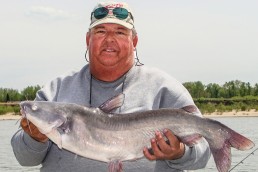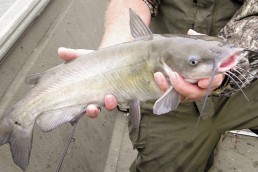2019 Catfish Forecast for Indiana’s Big Rivers
SHARE THIS POST
Hoosier catfish anglers have been enjoying some excellent fishing recently. Lucky fishermen in many parts of the state have caught giant blue catfish, oversized flathead catfish and bragging-sized channel catfish. It seems like catfish populations are thriving, and trophy-sized fish are becoming more numerous. But can that really be true?
Yes, it’s possible. There was a change in Indiana catfish regulations back in 2016, which was meant to increase the survival of younger catfish and help protect trophy-sized fish from over-harvest. The minimum length limit for catfish caught in streams and rivers increased from 10 inches to 13 inches, and anglers may now keep only one large catfish of each species per day, statewide (one blue catfish over 35 inches, one flathead over 35 inches, one channel catfish over 28 inches). The other bag limits remain unchanged.
Department of Natural Resources (DNR) fisheries biologists have been monitoring the state’s catfish populations since before the change in regulations. Although they reported in early 2019 that it is still too early to tell, catfish anglers have been catching lots of fish (including large fish) in many of our bigger waterways. Here are two catfish rivers that you should visit this summer.
The Ohio River
When Hoosiers talk about big-water catfish, chances are pretty good they are talking about Ohio River catfish. The mighty Ohio River is as big as it gets when it comes to large rivers in Indiana, and this famous waterway is absolutely teeming with catfish. Channel catfish, blue cats and flathead catfish are very abundant throughout this river system.
Catfish thrive in the Ohio River because it provides the different types of habitat required by them. Good current flow, deep holes, submerged rock ledges, shallow feeding bars, undercut banks and big logjams offer excellent places to live, breed and feed. All three species of catfish require the habitat delivered by the Ohio River.
Channel catfish are the most abundant catfish in the river, but serious whiskerfish anglers often overlook them. Even though they routinely reach weights of several pounds, channel catfish just don’t generate the excitement of trophy-sized blue catfish and flatheads. Average-sized blues and flatheads tip the scales at 10-15 pounds, and individuals of either species won’t raise many eyebrows until they reach 30-40 pounds.
Big Rivers Fisheries Biologist Craig Jansen from the Indiana DNR recently reported that the Ohio River’s catfish populations are strong. “Trotline catch rates in all areas we sampled were substantially higher this year,” he said. “Of course, that could be due to the fact that we switched from frozen shad as bait to fresh-cut Asian carp and buffalo. Carp and buffalo skin is so tough it stays on the hook much longer than shad.”
Indiana biologists continue to work with fisheries biologists from Kentucky when doing research on the Ohio River, and Indiana is responsible for catfish sampling in the JT Myers Pool each year. “The largest blue cat we caught from the Myers Pool in 2018 was 40.9 inches long and weighed 30.9 pounds. We caught a few flathead catfish, too, up to 32 inches long.”
The change in bait may have affected the Kentucky catch rates, also, but big blue catfish are definitely out there in good numbers. “In my conversations with the Kentucky biologists, they mentioned the Cannelton Pool was once again the most productive for big blue cats,” said Jansen. This is similar to what has been seen in previous years.
Are you enjoying this post?
You can be among the first to get the latest info on where to go, what to use and how to use it!
Since the Ohio River is such a well-known catfish hotspot, the Cabela’s King Kat Classic Tournament was held here in September, 2018. Anglers gathered at Jeffersonville and competed for two full days. The winning team fished the Cannelton Pool near Leavenworth and weighed-in a two-day total of 232 pounds, including a giant blue catfish weighing 64.9 pounds. The second place team fished the McAlpine Pool and caught 228.2 pounds of catfish, bolstered by their own trophy blue cat (55.4 pounds). The biggest fish of the event was caught by the third place team. It was a monstrous 71.3-pound blue catfish, also caught from the Cannelton Pool.
The Wabash River
Although the Wabash River is not as large and deep as the Ohio, it has the distinction of flowing through much more of Indiana. It starts out relatively small and shallow up north near Huntington, and it gradually winds its way to the western edge of the state and then heads south towards the Ohio River. The farther south it goes, the bigger it gets, too.
Like the Ohio River, the Wabash also features excellent catfish habitat, including sand and gravel bars, root wads, logjams, and deeper holes near river bends. Although the shallower water found throughout much of the river system is more conducive to channel catfish and flathead catfish than it is to blue cats, blues can be found in the Wabash wherever food and water depth is to their liking.
Fisheries biologist Craig Jansen is also responsible for managing the fish populations on the Wabash River, and he and his staff conducted a catfish monitoring survey here in the summer of 2018. They sampled four stretches of the river, including Williamsport, Beal, Montezuma and New Harmony. Catch rates were good throughout the river, but some places were better than others.
“We caught the most channel cats and flatheads throughout the Williamsport reach,” Jansen said. “That was the farthest upstream site that we checked last summer. We also found the greatest average size there, with channel cats averaging 17.2 inches long and flatheads averaging 23.1 inches. There is a general trend of less harvest by anglers and larger fish the farther upstream you go.”
Four of the five largest flathead catfish caught by biologists in 2018 were captured from the Williamsport area, but anglers can certainly catch large flatheads in other areas of the river, too. “The biggest flathead we caught on the Wabash in 2018 came from the New Harmony stretch in southern Indiana,” continued Jansen. “That fish was 48.4 inches and weighed 54 pounds.”
Blue catfish in the Wabash are found in greater numbers as you head downstream. The traditional stronghold for Wabash River blue catfish is from the confluence of the White River and Wabash, all the way downstream to the Ohio River. However, blue cats – even big blue cats – can be found in deep pockets throughout the river. “We caught the most blue catfish down by New Harmony,” Jansen said, “but we caught some blues at each of the four places we sampled. In fact, we caught eight blue cats at Montezuma and five at Williamsport.”
Regardless of whether you fish for catfish on the Ohio River or the Wabash, be sure your tackle is up to the task. While channel cats can be caught with almost any spin-cast or spinning gear, trophy-sized flathead catfish and blue cats will require heavy-duty tackle. Stiff rods, quality reels, heavy line and stout terminal will help ensure success once you hook the big one.
MWO
SHARE THIS POST
Did you enjoy this post?
You can be among the first to get the latest info on where to go, what to use and how to use it!
Tom Berg
A lifelong outdoorsman and award-winning outdoor writer and nature photographer, Tom Berg has been the Executive Director/Treasurer of the Hoosier Outdoor Writers group for the past 14 years. When he is not writing, he would rather be outside fishing, hunting or trapping than doing just about anything else.



